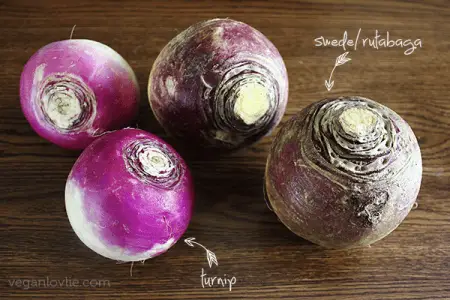Although completely different, some people may call turnips “rutabagas” and rutabagas “turnips.
” Why? Well, aside from the fact that both belong to the Brassica family, they also have a similar appearance. But what is the difference between the two? This will be discussed in this article.
Summary Table
| Turnip | Rutabaga |
| Scientifically known as Brassica rapa; also known as “white turnip” | Scientifically known as Brassica napobrassica; other names include “swede,” “yellow turnip,” or “waxed turnip” |
| Has white flesh; skin is usually white, white and purple, or white and red | Has yellow flesh; skin is a combination of dirty yellow and dark purple |
| Has a mild, sweet flavor | Sweet; dense; contains less moisture |
| Has a short shelf life; easy to cook | Cooks and stores longer |
| Thrives in temperate climates; needs moisture and organic matter in the soil | Can be grown in cold areas; needs rich and well-drained soil with less organic matter |
Definitions

A turnip, scientifically known as Brassica rapa, is a small, white-fleshed, bulbous root vegetable. Its skin is usually white, a combination of white and purple, or white and red. It has thick, dark green leaves.
In some areas, it is specifically called “white turnip.”
A turnip has a mild, sweet flavor. The taproot contains a high amount of vitamin C, while the leaves contain vitamin A, C, and K, folate, lutein, and calcium.
Turnips thrive in moist soil with high levels of organic matter.
They are abundant during the summer. The smaller varieties are preferred for cooking because they are more tender, while large varieties are usually used as animal feed.
The most famous varieties for human consumption are:
- Purple top
- Golden Ball
- White Globe
- White Egg
On the other hand, a rutabaga (Brassica napobrassica) is a large root vegetable with yellow flesh. Its thick skin is usually a combination of dirty yellow and dark purple, and its roots are dense and large. It is believed to be a combination of a turnip and a wild cabbage. In some areas, it is called “swede” or “yellow turnip.” Sometimes, it is called “waxed turnip” because of the wax that covers it to preserve it during the cold months.
The flesh of the rutabaga is sweet. It is dense so it takes a while to cook it. It also contains a small amount of moisture which means it is not highly perishable. Rutabaga roots contain vitamin B6, vitamin C, fiber, calcium, potassium, and phosphorus.
Rutabagas can be grown in cold areas as long as the soil is rich and well-drained. A high amount of organic matter in the soil may cause the roots to be deformed.
The most common kinds of rutabaga grown today are:
- American Purple Top
- Thomson Strain
- Laurentian
Turnip vs Rutabaga
What, then, is the difference between a turnip and a rutabaga?
A turnip (Brassica rapa) has white flesh. Its skin can be white, white and red, or white and purple.
On the other hand, a rutabaga (Brassica napobrassica) has yellow flesh and its skin is a combination of dirty yellow and dark purple.
In terms of size, taste, and texture, a turnip is smaller and has a milder taste than a rutabaga. A rutabaga is large and has a sweeter taste and a denser root, so it cooks and stores longer than a turnip. Moreover, commercially sold rutabagas are usually covered in wax to preserve them during the colder months.
A turnip needs a temperate climate and moist soil that is rich in organic matter, while a rutabaga thrives in cold areas with well-drained soil with less organic matter.
A turnip is sometimes called “white turnip,” while a rutabaga is sometimes called “yellow turnip,” “swede,” or “waxed turnip.”





